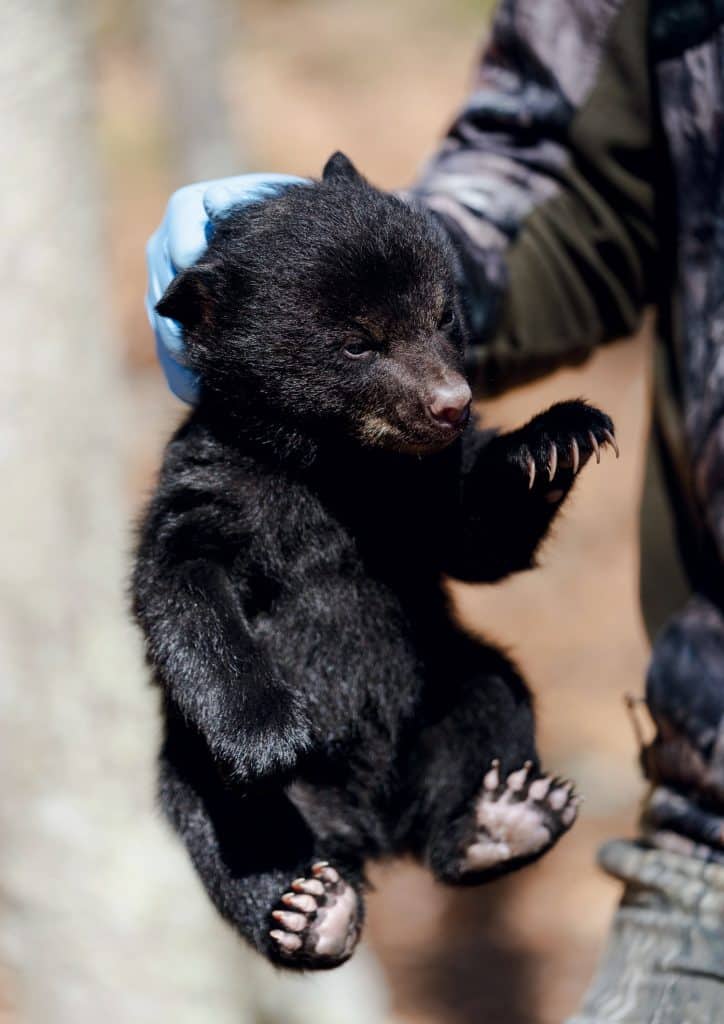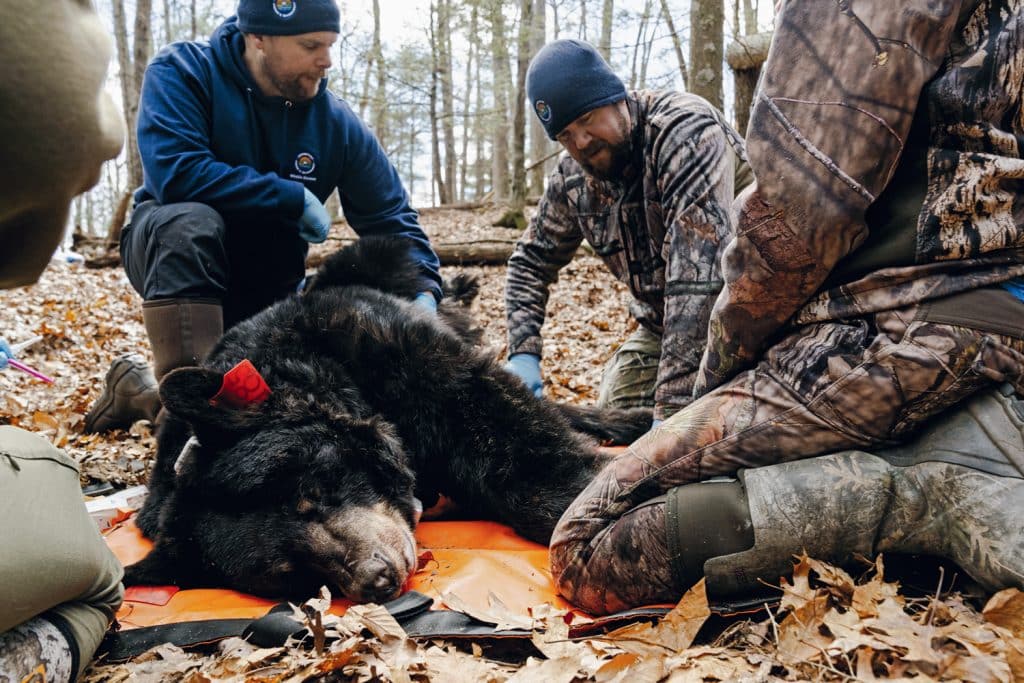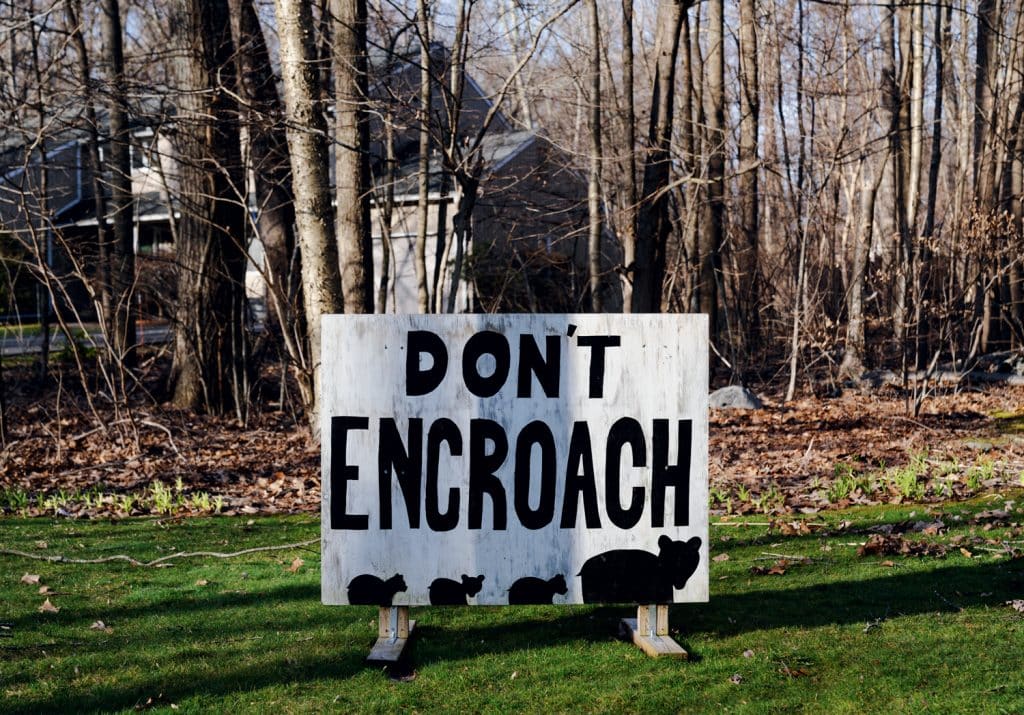The Bears Next Door | Black Bears in Connecticut
Wild animals need to be left alone—but in the small, densely populated state of Connecticut, that’s an increasingly tall order.

“Backyard Friend” from photographer Corey Arnold’s “Cities Gone Wild” project, originally published in National Geographic.
Photo Credit : Corey ArnoldBy Christine Woodside
A short walk from a suburban driveway in Canton, Connecticut, a black bear and her cub sleep in their den, a shallow depression in leaf duff underneath a small brush pile and a few downed trees. State biologists Jason Hawley and Melissa Ruszczyk and technicians Kaitlyn Place and Megan Graham quietly surround the den. They shoot a dart loaded with sedative into the slumbering mother bear. Right away, she bolts and scoots up a nearby hemlock tree, where she hangs on to semi-dead branches about 15 feet above the ground. She soon passes out while leaning on a sharp branch.
The crew stands below, peering up at her precarious position; Hawley worries the branch could block her breathing. One of the state staffers drives a pickup truck into the woods and parks beside the tree. Hawley jumps into the truck bed and shimmies up the tree. Hugging the trunk below the bear, he nudges her motionless body back and forth until finally she falls, grazing the truck and cracking its windshield.
Hawley has been through this kind of thing many times. “In my career I’ve had 140 to 150 bears fall out of trees,” he says. “Only one was injured.”
Soon, they have the bear sleeping peacefully on a tarp. She looks healthy: solid, shaped a little like a large 1950s refrigerator, and covered in sleek, dark brown fur. Her pink tongue hangs out a bit. Golden-tinged fur surrounds the pads of her giant paws. On her ear hangs an orange tag, “185.” This bear is sometimes called “Satan Bear” because she ranges near Satan’s Kingdom State Recreation Area on the Farmington River, west of Hartford, Connecticut.
The team members lean over her, doing their work. They take blood and saliva samples and change her GPS collar. The collar will help them track the bear’s movements in her home range and, within that range, her “core area”—the smaller region in which she spends at least half of her time.

Photo Credit : Sophie Park

Photo Credit : Sophie Park
The 2-month-old cub sits on the lap of state conservation officer Alexandra Blackwell, half inside her coat; it’s 43 degrees out. This cub is so young that she doesn’t mind a human holding her, but she will be naturally wary of people very soon, so the biologists have come now, before their presence might interfere. They hoist mama bear up in the tarp to weigh her, then slide her gently back into the shallow den and snuggle the cub beside her. After she wakes up, she will smell that humans have been here and will probably move her den uphill, dragging brush to create another semi-open shelter, rounding out an area in the ground to nurse and protect her cub.
The goal is that mother and cub will never remember this visit. It’s part of the team’s greater mission to keep Connecticut bears wild through study and guidance. What bears need the most, the biologists say, is to be left alone. But leaving bears alone can be difficult in Connecticut. The bears come to the people.
* * * * *
Black bears in Connecticut number around 1,200, most of them in the state’s rural and heavily forested northwest. But they are moving. With no natural predators and no hunting season here, they thrive, with little fear of humans while living ever closer to civilization. In the first four months of 2024, residents reported 1,888 bear sightings to the state’s Department of Energy and Environmental Protection (DEEP). Conflicts with bears—whether over trash cans, bird feeders, farm animals, or the like—were reported in more than half of the state, especially west of the Connecticut River.
For the past several years, bears have been expanding east and south into Avon, Granby, West Hartford, Farmington, Canton, Hartland, and other places west of Hartford. They are also moving south, near the shoreline of Long Island Sound. They seem unfazed by areas where streets, industry, and houses butt up against state forest and other natural lands. They are extending their territory by swimming across the Connecticut River. “Eastern Connecticut could support as many bears as western,” Hawley says. “It’s such good habitat that they will be there eventually.”
Connecticut’s recent bear-human encounters have been a mix of unnerving and downright scary. A bear tried to drag a 10-year-old boy into the woods in Morris in October 2022. Last year in Avon, a bear bit a 74-year-old woman out walking her dog, and another encounter made national news when a bear got into a crate of cupcakes outside an Avon bakery and did not budge until it had devoured five dozen. A Simsbury woman walked into her kitchen on a Friday afternoon this past May and found the pantry ransacked and a female bear eating and dragging food out to the deck, from which she had broken in via a screened window. State environmental police killed that bear, according to their policy, because she was using houses for food and would continue.
Although 70 to 80 percent of their diet is plants, especially acorns and berries, black bears will eat anything. They will eat turkey eggs, turkeys, deer fawns, dead deer, and other creatures. Hawley has watched bears dismantle a beaver lodge and grab the inhabitants. This is normal behavior by wild animals.

Photo Credit : Sophie Park
But normal for a Connecticut bear now also means ambling through town. Bears roam up driveways, through backyards, into garages and kitchens, looking for calories. They scoop birdseed out of dangling feeders; they pull lids off garbage cans and eat what they find. They steal farm animal feed. And they will make their dens near or under buildings, attracted to the warmth.
Western District conservation officer Jesse Nivolo says state police have answered burglary calls and found the “burglar” was a bear. “They don’t take anything of value, and they eat everything in the house,” he says.
Every year, a bear will break into a car somewhere. In Hartland, a bear smelled food inside a Toyota Prius and managed to open the door and climb in. Then it could not get out—and panicked. “Everything was destroyed,” Hawley says. “The steering wheel was gone.” In Sharon, a bear broke into a Volkswagen Rabbit that had been converted to biodiesel, running on used fryolator grease. The bear found jugs of the grease inside and ate it.
After the Craig family in Goshen found the shredded remains of an Amazon package that had gone missing from their front porch—with the bicycle helmet they’d ordered left behind—they placed a trail camera on a nearby tree. “Within a three-day period we had five large bears wander down our front walk,” Melissa Craig says.
On an early evening last October, Jay Cox was reading on his back deck in rural North Guilford. His golden retrievers, Bunker and Mosey, lay at his feet. He looked up and spotted a bear lumbering up toward the stone wall that ran below the deck. He called quietly to his wife, Dody. They moved the dogs inside and started filming. They remembered that earlier in the season they’d noticed knocked-down bird feeders and one of the suet cages discarded in the woods. Now the large bear—one not tagged by the state—swaggered to a feeder swinging from the branch of a dogwood tree and began scooping out and eating birdseed. A minute later, Cox says, the bear “gave it a little whack” and ambled away, back toward the woods.
“We took our feeders down,” he says. “We have not put them back up. I miss them. But I loved the bear. He was very dear. He was really cool.”
This bear has no name. That is what sets it apart from Bunker and Mosey. It is a wild animal, and it wants one thing: food. It does not want human love and acceptance. This is the difference that Connecticut’s bear biologists say people need to understand.
* * * * *
A major part of the bear biologists’ work is answering calls from people who don’t know what to do when bears walk onto their properties. The advice: block up the lattice under porches and decks, secure food, remove bird feeders. For the biologists, the response part of their job can feel like chasing their tails, Hawley says, because many bears here have no fear of humans. In Maine—the most bear-populated state in the Northeast—an annual hunting season has made bears leery of people. Hawley notes that his relatives in Maine have seen bears run away from bird feeders because they associate them with humans. But in Connecticut, it’s the opposite: Mother bears will teach their cubs to follow them to the feeders and the trash cans. Hawley is clearly frustrated. “There’s really nothing good about allowing bears access to these anthropogenic foods,” he says.
The increasing number of bear-human encounters in Connecticut resulted in the passing of a new state law last October. Among other things, Public Act 23-77 says people may legally kill bears if they are attacking a human or a domestic pet, or entering a building occupied by people. This brings up an obvious question: Should Connecticut legalize bear hunting? Hawley says a hunting season would change how bears act, making them more wary of humans. However, it would be a challenge to manage such a season, since about 80 percent of the state’s bear habitat is on private land.
Where Maine has fewer than 50 people per square mile, Connecticut has almost 750, making it the fourth most densely populated state. This not only complicates the issue of hunting but also puts stress on wildlife—including bears. While checking on and changing the collars of hibernating females in the first three months of 2024, the researchers found that 10 of them had borne no cubs this year. Though Hawley says they don’t know why this happened, it’s not unreasonable to think that stress could be a factor. Certainly, the biologists feel it: Much of what they do to study and protect bears gets noticed. Sometimes when they try to move a bear from an urban area, a crowd will gather nearby and start taking videos with their cellphones.
* * * * *
A recent controlled feeding study over two summers revealed how quickly bears adapt to human food—and how it can actually alter where they range. State biologist Melissa Ruszczyk placed barrels of trail mix in 10 secluded sites on state land within the home ranges of collared bears. The barrels were deliberately situated outside the animals’ core areas so that researchers could see whether wild bears used to wild food would change their movements around easily available human food. Most of the barrels were refilled regularly, but a few were left empty as a control; all were monitored by remote cameras.
Although she is still evaluating the observations, Ruszczyk says early results suggest that the bears—who fast developed a taste for the blend of fruit, nuts, and chocolate—organized their lives around those barrels, changing the core areas within their home ranges. Even at the barrels that were left empty, Ruszczyk notes, she saw bears that acted as if they expected something to be there. “Some bears would huff,” she says. “Some bears would walk right in and sit right next to you. As a bear biologist, it’s almost heartbreaking. It’s funny, but it’s really sad.”
Because these were wild sites and the experiment lasted for only two seasons, the bears quickly readjusted to finding wild food sources when the trail mix disappeared. Bears will not change their ways so easily when they’ve been eating human food in settled areas. They associate people with food, and if the food isn’t there, they start looking for it.
The dynamic becomes even more dangerous when people intentionally feed bears. In many areas of Connecticut, people have fed wild bears regularly so that they return again and again, expecting food. This is, as Ruszczyk puts it, “the ultimate selfishness.”
“There are people out there, whether they are doing this unintentionally or intentionally, that have had these chronic food sources available to bears for a decade,” Hawley says. “If this is a female bear, she’s having cubs every other year, so the yearlings stay with her for a year and three months. They’re experiential learners, so they don’t have a chance. Because this is what she’s teaching them: Hey, there’s acorns over here, but this is way better, kids. You can come here and get 10,000 calories in 30 minutes, whereas if you go out and forage acorns, it’s going to take three days. That’s what we were trying to get at, to show how bad this really is.”
Cubs learning to eat human food will grow up, have their own families, and teach them to eat human food. They do have the instinct to look for wild food if human food is removed, but if they’ve been relying on the latter for generations, that switch will take time.
* * * * *
Connecticut’s bear biologists say they spend more time teaching people how to manage the bear-food proximity than they spend studying bears. Hawley says that DEEP hopes to add a provision in wildlife regulations that will allow them to issue warnings to anyone who leaves out bird feeders that result in regular bear visits.
In 2020, the town of Simsbury passed an ordinance that requires bird feeders be removed between April 1 and November 30; it also prohibits the intentional feeding of wildlife and the improper storage of food, garbage, and other wildlife lures. The penalty: $250 per offense, with the threat of legal action after two offenses.
In 2021 the town of Granby passed a similar ordinance specific to the feeding of black bears. “We aren’t getting a lot of complaints now,” says Captain Kurt LaFlamme of the Granby Police Department. “The ordinance has definitely been helpful.”
Granby residents have seen so many problems with bears and humans that they may have been more than ready for the ordinance. For years, one resident fed bears in her yard, and eventually her neighbors, whose children encountered bears every time they played, put their house on the market. It took forever for the house to sell, the story in town goes.
That brings up the elusive difference between emotional love for a wild animal and respect for a wild animal. Consider that sleeping mother bear in Canton: Anyone watching her, as the biologists took their samples and changed her collar, and noticing how her fur ruffled as they settled her back into her den, may have found it easy to love that animal. Anyone might have wanted to linger, just a bit, in her presence. But in order to keep this bear wild, the humans knew they had to depart.
Jennifer Abalan Kershaw knows firsthand what that tug of emotional attachment feels like. As animal control officer in three bear-heavy towns—Granby, Hartland, and Barkhamsted—she spends a lot of her time dealing with bear interactions and teaching people how not to attract bears—and what to do when the bears come anyway.
Eight years ago Kershaw rescued a bear cub, whose mother apparently had been killed, who kept showing up on people’s porches. She lured the cub into her vehicle with French toast (“I put it out for her, and she went for it,” she recalls) and then took her to a private wildlife rehabilitator. Kershaw chose not to involve the state wildlife division in the rescue, she says, because she feared the cub might be euthanized.
A few months later, she watched as the rehabilitator released the cub into the wild.
“I cried like a baby to see her get set free, back into the wilderness,” Kershaw says. “She went running like she’s supposed to. She didn’t lollygag and turn around. I hope she’s out there producing babies, and is safe and in the woods.”


